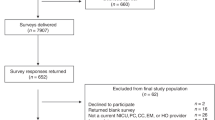Abstract
Objective: To assess the relationship between gender, background, and brief training and physicians’ detection of and treatment for woman abuse.
Design: Quasi-experimental and correlational designs, plus control for background factors.
Setting: Two residency training programs: general internal medicine and family practice.
Participants: Thirty-five participants were residents and four were faculty members; 17 were trained and 22 were untrained physicians; 20 were women and 19 were men.
Measures: Immediately after an encounter with each physician, a standardized patient rated speed of detection, history taking, planning, and focus on psychosocial issues.
Results: Women tended to detect the abuse earlier and take a more thorough history. Trained and untrained groups did not differ on any outcome variable. Prior professional training and having personally known a victim were positively associated with outcome, especially among men.
Conclusions: Referrals might best be made to women counselor/advocates. More extensive training of all personnel may be needed than that provided in this study.
Similar content being viewed by others
References
Straus MA, Gelles RJ. Physical Violence in American Families. New Brunswick, NJ: Transactions, 1990.
Appleton W, Renton W. The battered woman syndrome. Ann Emerg Med. 1980:9;84–91.
Hamberger LK, Saunders DG, Hovey M. Prevalence of domestic violence in community practice and rate of physician inquiry. Fam Med. 1992;24:283–7.
Sugg NK, Inui T. Primary care physicians’ response to domestic violence: opening the Pandora’s box. JAMA. 1992;267:3157–60.
Mascia C. A study of the treatment of battered women in emergency room settings. Doctoral dissertation, Kent State University, 1983 (University Microfilms International, Ann Arbor, MI).
Mandel JB. Clinical training to identify and treat battered women. Fam Pract Recertification. 1985;7:27–38.
Adamowski K, Burns N. Family Violence Training Project. Unpublished report, Ottawa General Hospital, Ottawa, Ontario, Canada, 1989.
Rose K, Saunders DG. Nurses’ and physicians’ attitudes about woman abuse: the effects of gender and professional role. Health Care for Women International. 1986;7:427–38.
Kellermann AL. Domestic violence and the internist’s response: Advocacy or apathy? J Gen Intern Med. 1990;5:89–90.
Stillman PL, Swanson DB, Smee S, et al. Assessing clinical skills of residents with standardized patients. Ann Intern Med. 1986;105:762–71.
Kure D. Emergency department responses to battered women: resistance to medicalization. Soc Probl. 1987;34:69–81.
Author information
Authors and Affiliations
Additional information
Supported in part by USPHS/HRSA training grant 5D28-PE15218 (Norman Jensen, MD, Director).
Rights and permissions
About this article
Cite this article
Saunders, D.G., Kindy, P. Predictors of physicians’ responses to woman abuse. J Gen Intern Med 8, 606–609 (1993). https://doi.org/10.1007/BF02599714
Issue Date:
DOI: https://doi.org/10.1007/BF02599714




